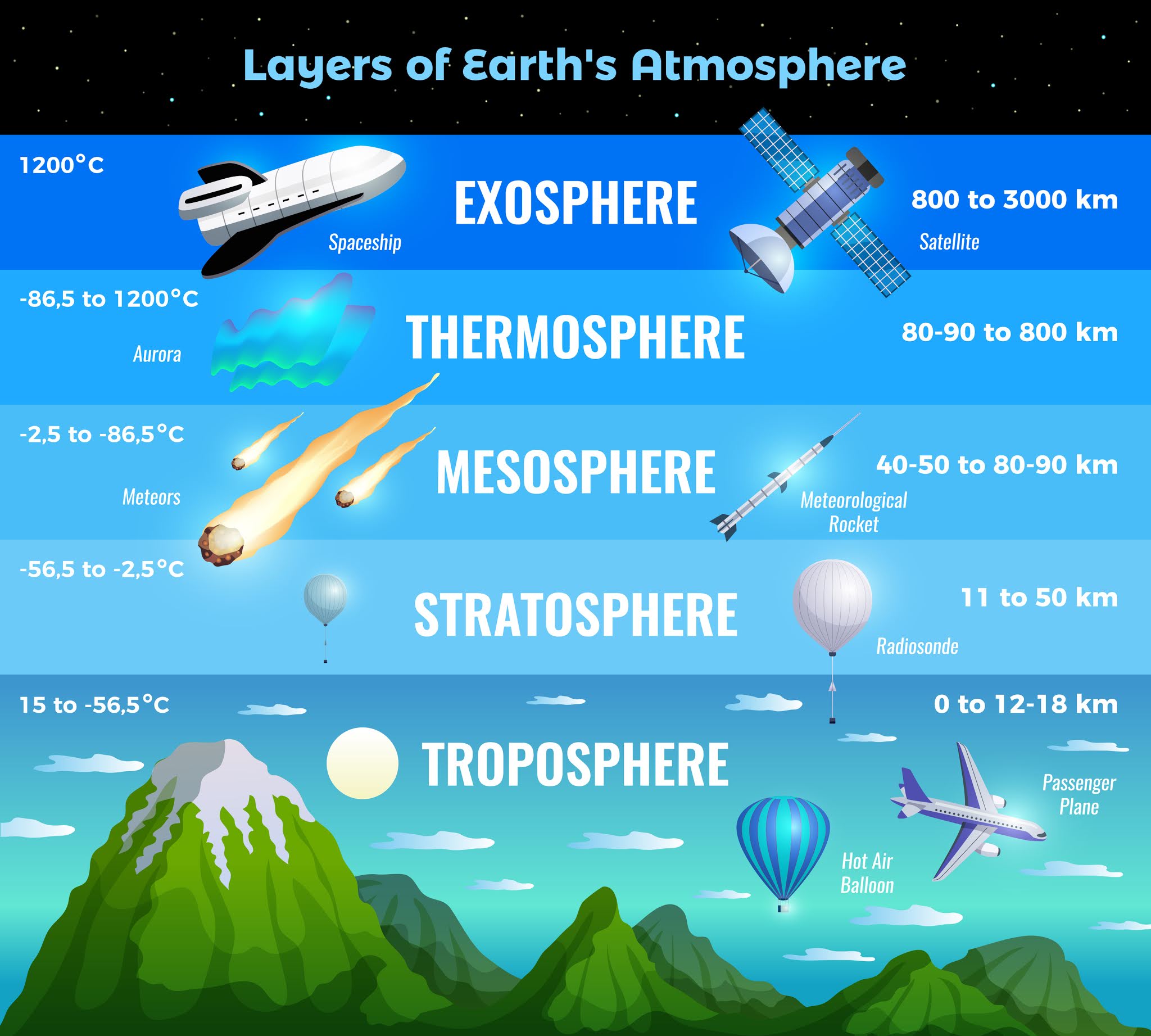Layers of Earth's Atmosphere

1. Troposphere
-
Height: Extends from the Earth's surface up to 8-15 km (5-9 miles), depending on location (higher at the equator, lower at the poles).
-
Thickness: Approximately 8-15 km.
-
Elements Abundant: Nitrogen (78%), Oxygen (21%), Argon, Carbon Dioxide, and Water Vapor.
-
Purpose:
Contains most of the atmosphere's mass and water vapor.
-
Responsible for weather phenomena like rain, storms, and clouds.
Supports life by providing breathable air.
-
Key Features:
Temperature decreases with altitude.
-
The boundary between the troposphere and stratosphere is called the tropopause.
2. Stratosphere
-
Height: Extends from 15 km to 50 km (9-31 miles) above the Earth's surface.
-
Thickness: Approximately 35 km.
-
Elements Abundant: Ozone (O), Nitrogen, Oxygen.
-
Purpose:
-
Contains the ozone layer, which absorbs harmful ultraviolet (UV) radiation from the Sun.
Provides a stable environment for jet aircraft to fly.
-
-
Key Features:
-
Temperature increases with altitude due to ozone absorption of UV radiation.
-
The boundary between the stratosphere and mesosphere is called the stratopause.
-
3. Mesosphere
-
Height: Extends from 50 km to 85 km (31-53 miles) above the Earth's surface.
-
Thickness: Approximately 35 km.
-
Elements Abundant: Nitrogen, Oxygen, and trace amounts of other gases.
-
Purpose:
-
Protects Earth by burning up meteoroids entering the atmosphere.
Plays a role in atmospheric tides and waves.
-
-
Key Features:
-
Temperature decreases with altitude, making it the coldest layer.
-
The boundary between the mesosphere and thermosphere is called the mesopause.
-
4. Thermosphere
-
Height: Extends from 85 km to 600 km (53-372 miles) above the Earth's surface.
-
Thickness: Approximately 515 km.
-
Elements Abundant: Oxygen, Nitrogen, and trace amounts of Helium.
-
Purpose:
-
Absorbs high-energy X-rays and UV radiation from the Sun.
-
Hosts phenomena like the Aurora Borealis and Aurora Australis.
Provides a medium for satellite orbits.
-
-
Key Features:
-
Temperature increases with altitude, reaching up to 2,000°C (3,600°F).
-
The boundary between the thermosphere and exosphere is called the thermopause.
-
5. Exosphere
-
Height: Extends from 600 km to 10,000 km (372-6,200 miles) above the Earth's surface.
-
Thickness: Approximately 9,400 km.
-
Elements Abundant: Hydrogen and Helium.
-
Purpose:
-
Acts as the transition zone between Earth's atmosphere and outer space.
Allows atoms and molecules to escape into space.
-
-
Key Features:
Extremely thin air, with particles moving freely.
Satellites orbit within this layer.
Summary:
Earth's atmosphere is a vital and complex system that protects life, enables weather phenomena, and supports technological advancements like satellite communications. Divided into five layers—Troposphere, Stratosphere, Mesosphere, Thermosphere, and Exosphere—each plays a unique role in maintaining the balance of our planet.
From providing oxygen for living organisms in the Troposphere to shielding us from harmful solar radiation in the Stratosphere, and even creating natural spectacles like auroras in the Thermosphere, the atmosphere is both a shield and a dynamic environment. Its characteristics, such as varying thickness, elemental composition, and temperature trends, reflect the delicate interplay of physical and chemical processes that sustain life on Earth.
By understanding the layers of the atmosphere, we can better appreciate their significance and take proactive steps to protect this invaluable system from challenges such as pollution and climate change. Each layer is not just a physical boundary but a critical contributor to Earth's ecosystem. Let's continue exploring and safeguarding this extraordinary marvel of nature.
👍🏻 1.1k
Comments
Post a Comment
Tell us your feedback!